 Brown GETTING INT GETTING INTO THINKING ABOUT GOINGMEDICAL O TO MEDICAL SCHOOL?M BETTER READ THIS BOOK! EDGetting into Medical School has a well-earned reputation as a SCHOOL trusted resource for prospective medical students looking to improve their chances for admission. This new edition has been I THE PREMEDICAL STUDENTS GUIDEBOOK CA updated with even more important advice, including: TWELFTH EDITION Undergraduate courses you should take LSanford J. Brown, M.D. How to prepare for the MCATMedical College Admission Testand get your highest score SCHOOL The ins and outs of applying to medical school How to ace the personal interview and also handle mini multiple interviews (MMI)the newest type of student interview The benefits of taking a gap yearand making the most of that time It also features a medical school directory with an up-to-date listing TWELFTH EDITION of tuition and fees, academic requirements, and application and enrollment information for more than 170 accredited medical and osteopathic colleges across the United States. Also includes a list of Web sites that provide helpful information to medical school candidates. ISBN: 978-1-4380-0690-1 EAN STUDYGREEN.LESS THAN ONE-HALF OF ALL MEDICAL SCHOOL APPLICANTS $14.99 Canada $17.99 Printed on partially recycled paper www.barronseduc.com Fully recyclable ARE ACCEPTED. LEARN HOW YOU CAN MAKE THE CUT! 4-0690-GetIntoMedSchl-fbs.indd All Pages 3/18/16 12:25 PM GETTING INTO MEDICAL SCHOOL THE PREMEDICAL STUDENTS GUIDEBOOK THE PREMEDICAL STUDENTS GUIDEBOOK 4-0690_GetMedSchool_12th_00FM.indd 2 3/21/16 10:33 AM GETTING INTO MEDICAL SCHOOL THE PREMEDICAL STUDENTS GUIDEBOOK TWELFTH EDITION Sanford J.
Brown GETTING INT GETTING INTO THINKING ABOUT GOINGMEDICAL O TO MEDICAL SCHOOL?M BETTER READ THIS BOOK! EDGetting into Medical School has a well-earned reputation as a SCHOOL trusted resource for prospective medical students looking to improve their chances for admission. This new edition has been I THE PREMEDICAL STUDENTS GUIDEBOOK CA updated with even more important advice, including: TWELFTH EDITION Undergraduate courses you should take LSanford J. Brown, M.D. How to prepare for the MCATMedical College Admission Testand get your highest score SCHOOL The ins and outs of applying to medical school How to ace the personal interview and also handle mini multiple interviews (MMI)the newest type of student interview The benefits of taking a gap yearand making the most of that time It also features a medical school directory with an up-to-date listing TWELFTH EDITION of tuition and fees, academic requirements, and application and enrollment information for more than 170 accredited medical and osteopathic colleges across the United States. Also includes a list of Web sites that provide helpful information to medical school candidates. ISBN: 978-1-4380-0690-1 EAN STUDYGREEN.LESS THAN ONE-HALF OF ALL MEDICAL SCHOOL APPLICANTS $14.99 Canada $17.99 Printed on partially recycled paper www.barronseduc.com Fully recyclable ARE ACCEPTED. LEARN HOW YOU CAN MAKE THE CUT! 4-0690-GetIntoMedSchl-fbs.indd All Pages 3/18/16 12:25 PM GETTING INTO MEDICAL SCHOOL THE PREMEDICAL STUDENTS GUIDEBOOK THE PREMEDICAL STUDENTS GUIDEBOOK 4-0690_GetMedSchool_12th_00FM.indd 2 3/21/16 10:33 AM GETTING INTO MEDICAL SCHOOL THE PREMEDICAL STUDENTS GUIDEBOOK TWELFTH EDITION Sanford J.
Brown, M.D. Director, Mendocino Foundation for Health Education and Premedical Advising Family Practice and Preventive Medicine, Fort Bragg, California Fellow, American Academy of Family Physicians 4-0690_GetMedSchool_12th_00FM.indd 3 3/21/16 10:33 AM Copyright 2016, 2011, 2006, 2001, 1997, 1989, 1983, 1981, 1979, 1978, 1975, 1974 by Barrons Educational Series, Inc. All rights reserved. No part of this publication may be reproduced or distributed in any form or by any means without the written permission of the copyright owner. All inquiries should be addressed to: Barrons Educational Series, Inc. 250 Wireless Boulevard Hauppauge, New York 11788 www.barronseduc.com Library of Congress Control No. 2015026287 ISBN: 978-1-4380-0690-1 Library of Congress Cataloging-in-Publication Data Brown, Sanford Jay, 1946 Getting into medical school / Sanford J.
Brown.Twelfth edition. pages cm Includes bibliographical references and index. ISBN: 978-1-4380-0690-1 1. Medical collegesUnited StatesAdmission. 2. 3. 3.
Premedical educationUnited States. I. Title. R838.4.B76 2016 610.71'173dc23 2015026287 PRINTED IN CANADA 9 8 7 6 5 4 3 2 1 4-0690_GetMedSchool_12th_00FM.indd 4 4/12/16 11:42 AM Dedication This edition of Getting Into Medical School is dedicated to the memory of Dr. Sidney Shindell, who was head of the Department of Preventive Medicine at the Medical College of Wisconsin when I applied there as an atypical premedical student in 1969. Dr.
Shindell became my advocate on the admissions committee, persuaded the other committee members that I was worthy of admission, and allowed me entry into the profession that I have loved for these past 40 years. Acknowledgments For help editing, revising, and updating chapters in this twelfth edition of Getting Into Medical School, I am beholden to and deeply appreciative of the work of members of UC Berkeleys premedical community: Julia Baek and Alan Deng for Choosing a College, Choosing a Major, and ThePremed Syndrome; Anjali Jain and Jacqueline Zhu for The Medical CollegeAdmission Test; Stefan Masselink, Bryan Bui, Danielle Li, and John Huh for Applying to a Medical SchoolWhen, Where, and How; Hung Nguyen and Jennifer Tan for Rejection and Your Alternatives; Janice Chau and Brandon Chau for Taking a Gap Year; Matthew Lum and Alex Qian for the Survival Bibliography; and Christine Norris for her work on TheFuture of Medicine. A special thanks to Alex Qian for spearheading this project, numerous contributions to the text, being lopsided, and introducing me to the world of Google folders and documents. I also want to thank my editors, David Rodman and April Martinez, for assuming responsibility for updating the information on individual medical schools. Finally, I want to thank my readers for keeping Getting Into MedicalSchool in print these many years. I know from your correspondence that many of you have been successful in your quest to become physicians, in small part from this book, and that has been most gratifying to me.
May you all find happiness in your healing art. 4-0690_GetMedSchool_12th_00FM.indd 5 3/21/16 10:33 AM 4-0690_GetMedSchool_12th_00FM.indd 6 3/21/16 10:33 AM Contents PREFACE ix INTRODUCTION xi1 Choosing a College,Choosing a Major Its Not Where You Go to School or What You Study, 1 The Myth of the Premedical Major, 2 Getting As in the Sciences, 3 The Physician As a Scientist, 4 Abraham Flexner and His Flexner Report, 5 Emphasis on the Sciences, 6 What Kind of Doctor Do You Want to Become? 7 Avoid the Extra Science Courses, 9 2 The Premed Syndrome The Premedical Mind, 11 The Premedical Society and the Premedical Adviser, 12 Does Your Adviser Attend the Meetings? 13 Get AcquaintedSee What They Write About You, 15 The Premedical Student, 17 The Premedical Syn drome, 19 Failure Is Always a Possibility, 20 3 The Medical CollegeAdmission Test (MCAT) The Most Important Criterion, 21 MCATa Means for Comparison, 22 The Test, 24 Registering for MCAT and Test Day, 24 The New MCAT, 25 How Is It Scored? 26 Preparing for the MCAT, 27 Preparatory Courses, 28 4 Applying to a MedicalSchoolWhen, Where, and How Where to Apply? 33 How Many Schools to Apply To? 34 When to Apply, 36 How to Apply, 37 Early Assurance Programs, 40 Early Decision, 40 Combined MD/PhD Programs, 41 Cost of Applying, 42 Meeting the Costs, 43 Minority Students, 46 Stay ing In Can Be Harder Than Getting In, 48 Women, 48 Special Interest Groups, 50 What Makes You Different?: Well-rounded vs Lopsided, 50 Recommendations, 57 AMCAS Letter Service, 61 The Interview, 63 Sample Personal Statements, 69 viii G E T T I N G I N T O M E D I C A L S C H O O L 5 How Medical School AdmissionsCommittees Evaluate Applicants Can the Applicant Make It? 75 Determining the Motivation, 77 6 Rejection and Your Alternatives Rejection and Reapplication, 81 Consider Reapplying, 82 The Post-baccalaureate, 89 Osteopathy, 92 Attending an Interna tional Medical School, 94 7 Amazing Success Stories8 The Future of MedicineAppendixes Appendix I: Mini Multiple Interview Questions Appendix II: Internet Advising: Saras Story Appendix III: Summer Programs for the Premed and Taking a Gap Year Appendix IV: Directory of American Medical Schools Appendix V: Directory of U.S. Schools of Osteopathic Medicine Appendix VI: Survival Bibliography Index to U.S. Medical SchoolsIndex to U.S. Osteopathic Schools 4-0690_GetMedSchool_12th_00FM.indd 8 3/21/16 10:33 AM Preface So, you want to go to medical school and become a doctor. Thats why, I assume, youve picked up this book.
But are you serious, or are you a dil-ettante? Are you able to make the sacrifices that going to medical school will require of you, or are you just toying with the idea? Are you ready to jump into the water and sink or swim, or are you just going to get your toes wet? Getting into medical school is hard work, even for the best and bright est. You will spend four years in college taking courses that will only qualify you to apply and are no guarantee of getting accepted. A grade point average of 3.5 or better will be a minimum requirement and then you will have to take a standardized examination, the MCAT, which will count more than your college GPA that you sweated four years over as a criterion for admission. You will need to shadow doctors while in college, spend summers in medical environments, and, ultimately, work a year or two after graduation at medically related jobs to gain credibility as an aspiring physician. During your senior year, you will spend countless hours writing your medical school applications, garnering letters of recommenda tion, and, if you are lucky enough, flying around the country at your own expense going to interviews that still will not guarantee you a place in the freshman class. On top of it all, unless you are independently wealthy, you have to be willing to assume a staggering debt to finance your medical education.
Next page
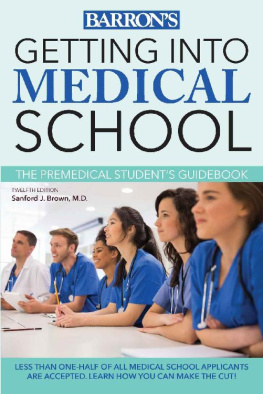

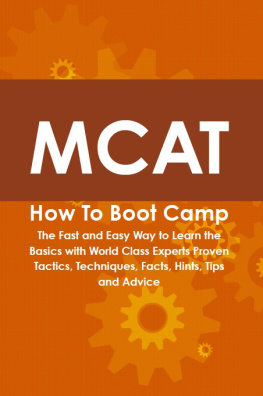
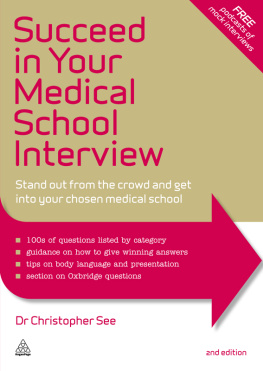
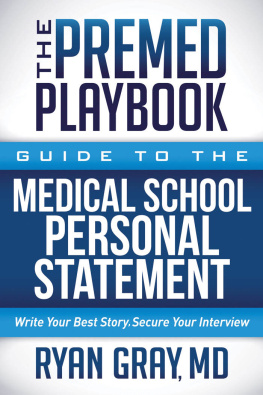
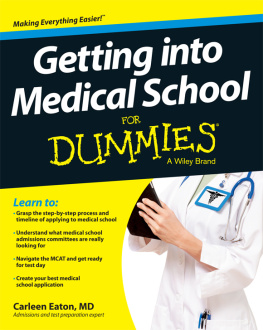

 Brown GETTING INT GETTING INTO THINKING ABOUT GOINGMEDICAL O TO MEDICAL SCHOOL?M BETTER READ THIS BOOK! EDGetting into Medical School has a well-earned reputation as a SCHOOL trusted resource for prospective medical students looking to improve their chances for admission. This new edition has been I THE PREMEDICAL STUDENTS GUIDEBOOK CA updated with even more important advice, including: TWELFTH EDITION Undergraduate courses you should take LSanford J. Brown, M.D. How to prepare for the MCATMedical College Admission Testand get your highest score SCHOOL The ins and outs of applying to medical school How to ace the personal interview and also handle mini multiple interviews (MMI)the newest type of student interview The benefits of taking a gap yearand making the most of that time It also features a medical school directory with an up-to-date listing TWELFTH EDITION of tuition and fees, academic requirements, and application and enrollment information for more than 170 accredited medical and osteopathic colleges across the United States. Also includes a list of Web sites that provide helpful information to medical school candidates. ISBN: 978-1-4380-0690-1 EAN STUDYGREEN.LESS THAN ONE-HALF OF ALL MEDICAL SCHOOL APPLICANTS $14.99 Canada $17.99 Printed on partially recycled paper www.barronseduc.com Fully recyclable ARE ACCEPTED. LEARN HOW YOU CAN MAKE THE CUT! 4-0690-GetIntoMedSchl-fbs.indd All Pages 3/18/16 12:25 PM GETTING INTO MEDICAL SCHOOL THE PREMEDICAL STUDENTS GUIDEBOOK THE PREMEDICAL STUDENTS GUIDEBOOK 4-0690_GetMedSchool_12th_00FM.indd 2 3/21/16 10:33 AM GETTING INTO MEDICAL SCHOOL THE PREMEDICAL STUDENTS GUIDEBOOK TWELFTH EDITION Sanford J.
Brown GETTING INT GETTING INTO THINKING ABOUT GOINGMEDICAL O TO MEDICAL SCHOOL?M BETTER READ THIS BOOK! EDGetting into Medical School has a well-earned reputation as a SCHOOL trusted resource for prospective medical students looking to improve their chances for admission. This new edition has been I THE PREMEDICAL STUDENTS GUIDEBOOK CA updated with even more important advice, including: TWELFTH EDITION Undergraduate courses you should take LSanford J. Brown, M.D. How to prepare for the MCATMedical College Admission Testand get your highest score SCHOOL The ins and outs of applying to medical school How to ace the personal interview and also handle mini multiple interviews (MMI)the newest type of student interview The benefits of taking a gap yearand making the most of that time It also features a medical school directory with an up-to-date listing TWELFTH EDITION of tuition and fees, academic requirements, and application and enrollment information for more than 170 accredited medical and osteopathic colleges across the United States. Also includes a list of Web sites that provide helpful information to medical school candidates. ISBN: 978-1-4380-0690-1 EAN STUDYGREEN.LESS THAN ONE-HALF OF ALL MEDICAL SCHOOL APPLICANTS $14.99 Canada $17.99 Printed on partially recycled paper www.barronseduc.com Fully recyclable ARE ACCEPTED. LEARN HOW YOU CAN MAKE THE CUT! 4-0690-GetIntoMedSchl-fbs.indd All Pages 3/18/16 12:25 PM GETTING INTO MEDICAL SCHOOL THE PREMEDICAL STUDENTS GUIDEBOOK THE PREMEDICAL STUDENTS GUIDEBOOK 4-0690_GetMedSchool_12th_00FM.indd 2 3/21/16 10:33 AM GETTING INTO MEDICAL SCHOOL THE PREMEDICAL STUDENTS GUIDEBOOK TWELFTH EDITION Sanford J.